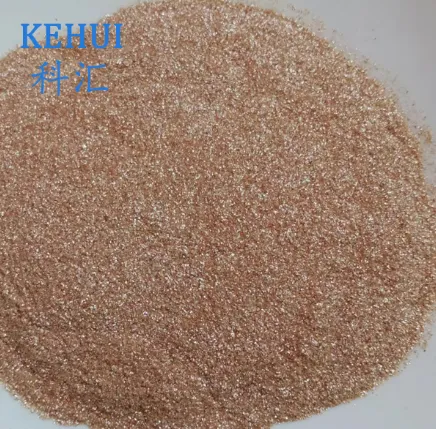కాల్సిన్డ్ మైకా, As a high-temperature treated mica product, it has demonstrated significant application value in multiple industrial fields due to its unique physical and chemical properties. By high-temperature calcination, the moisture and volatile substances in mica are removed, making its structure more stable and significantly improving its electrical and heat resistance properties. These characteristics have opened up new application spaces for Calcined Mica beyond traditional mica applications and brought new development opportunities to related industries.

Calcined Mica plays an important role in the field of electrical insulation materials
Due to the significant improvement in electrical resistivity and insulation strength after high-temperature calcination, calcined mica for decoration can be used as a high-quality electrical insulation material in electrical equipment such as motors, capacitors, and electric heaters. Compared to uncalcined mica, Calcined Mica can better adapt to harsh working environments such as high temperature and high pressure, ensuring the stable operation of equipment. In addition, Calcined Mica can also be used to manufacture high-performance insulation paper, insulation boards, and insulation paints, providing reliable insulation protection for power electronic equipment.
Calcined Mica also plays a key role in the field of refractory materials
After calcination treatment, the heat resistance and thermal shock resistance of calcined mica powder are significantly enhanced, enabling it to withstand severe temperature changes in high-temperature environments without easily cracking or deforming. Therefore, calcified mica powder is widely used in the manufacturing of high-temperature kiln linings, casting coatings, and ceramic materials. It can effectively improve the overall performance of refractory materials, extend their service life, and reduce energy consumption in high-temperature industrial production processes.
Calcined Mica is widely used in the coatings and plastics industry
As a functional filler, calcined mica for electrical insulators can improve the weather resistance, wear resistance, flame retardancy, and UV resistance of coatings and plastic products. Its sheet-like structure endows coatings and plastic products with good glossiness and covering power. In the fields of automotive coatings, architectural coatings, and engineering plastics, the application of Calcined Mica can effectively enhance the added value and market competitiveness of products.
In summary, calcined mica for welding electrodes has demonstrated significant application value in various fields such as electrical insulation materials, refractory materials, coatings, and plastics due to its excellent electrical insulation, heat resistance, and chemical stability. With the continuous advancement of technology and the continuous development of industrial technology, it can be foreseen that the application fields of Calcined Mica will further expand, and it will play a more important role in promoting the development of related industries. In the future, research on Calcined Mica modification technology and new applications will be the development direction to better meet the needs of different industries and further enhance its application value.
Calcined Mica FAQs
What is Calcined Mica?
Calcined Mica is the product of high-temperature calcination treatment of natural mica, such as muscovite or phlogopite. The calcination process (usually 700900 ° C) removes crystalline water and volatile impurities from mica, causing changes in its physical and chemical properties, such as increased hardness, whiteness, enhanced insulation, and more stable structure.
What is the difference between Calcined Mica and ordinary mica?
Thermal stability: After calcination, the temperature resistance is higher (up to 1000 ° C or above), and ordinary mica is prone to delamination (500-600 ° C).
Color: Calcined Mica is whiter (impurities oxidize and decompose), while ordinary mica may have a yellow gray tone.
Electrical performance: After calcination, the dielectric loss is lower and the insulation is better.
Water absorption: Calcined Mica has significantly reduced moisture absorption and better moisture resistance.
What are the main uses of Calcined Mica?
High end coatings: used for high-temperature resistant coatings, anti-corrosion coatings, or aerospace coatings.
Plastic rubber: enhances the thermal deformation temperature and dimensional stability of composite materials.
Electronic materials: high-frequency insulation materials, high-performance circuit board substrates.
Cosmetics: High whiteness Calcined Mica is used as a pearlescent agent (without heavy metals).
Ceramic glaze: improves the gloss and heat resistance of the glaze surface.
What are the key points of the machining process for Calcined Mica?
Temperature control: The calcination temperature needs to be adjusted for different types of mica (such as higher temperature for gold mica).
Atmosphere and Environment: Avoid reducing atmospheres that can cause discoloration of iron impurities.
Post treatment: After calcination, it needs to be crushed and graded, and some applications require surface modification (such as silanization).
How to choose the specifications of Calcined Mica?
Attention should be paid to the following based on the application scenario:
Particle size distribution: 550 μ m for coatings and 10100 μ m for plastic fillers.
Whiteness: Cosmetic grade requirement>90% (ISO brightness standard).
Electrical performance: Electronic grade requires testing of dielectric constant and breakdown voltage.
Impurity content: Metal oxides such as Fe ₂ O ∝ should be less than 0.5%.
-
The Versatile World of Phlogopite Mica: Properties, Forms, and Applicationsవార్తలుJul.14,2025
-
The Versatile Applications of Calcined Mica: From Decoration to Industrial Useవార్తలుJul.14,2025
-
The Role of Muscovite Mica in Industrial Insulation Materialsవార్తలుJul.14,2025
-
The Benefits of Using Expanded Clay Pebbles in Hydroponics and Soil Gardeningవార్తలుJul.14,2025
-
Innovative Applications of Mica Flake in Paints and Coatingsవార్తలుJul.14,2025
-
Gardening Expanded Clay Usage: A Complete Guideవార్తలుJul.14,2025
-
The Use of Natural Mica Powder in Skincare Productsవార్తలుJun.11,2025








